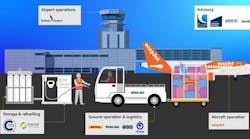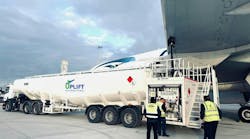Jan. 14--It will take 30 years at current rates for dangerous levels of contamination from a Kirtland Air Force Base fuel spill to reach Albuquerque's nearest municipal drinking water well, according to preliminary results from a new analysis by the federal Environmental Protection Agency.
The EPA also concluded that Albuquerque's drinking water wells could be protected by an aggressive pump-and-treat program that pulls contaminated water from the ground, slowing its spread.
The draft EPA study is the most detailed analysis yet of the speed at which contamination from a decades-old Air Force fuel spill might reach drinking water wells, where it could pose a threat to public health. The Air Force discovered in 1999 that an underground pipe at Kirtland's aircraft fuel loading facility was leaking, likely for decades.
The new time frame, which is longer than previous estimates, gives state and federal officials some breathing room, said Tom Blaine, who is overseeing cleanup efforts for the New Mexico Environment Department.
"It takes it out of crisis mode," Blaine said in an interview Monday. But he cautioned that the preliminary results are only one of a number of studies aimed at nailing down how quickly the contamination might reach drinking water wells.
Blaine's staff had previously estimated that contamination might reach the Albuquerque Bernalillo County Water Utility Authority's nearest well in five to seven years. He said Monday the Environment Department staff is still studying the new report to try to understand the difference between the two estimates.
An Air Force spokesman said EPA's data, along with other studies, will be used to develop a final cleanup plan for the spill.
The EPA released the draft report Monday after receiving a Freedom of Information Act request from Citizen Action, an Albuquerque group.
The EPA report concluded that a small drinking water well at the Raymond G. Murphy VA Medical Center in Albuquerque could see contamination sooner, possibly in as little as two to three years, though officials cautioned that more analysis of the VA result is needed.
Located adjacent to Kirtland, the VA hospital tests its drinking water once a month and so far has found no evidence of contamination from the Kirtland spill, said Juliana Hankins, the hospital's chief of engineering. The VA has a plan in place that would enable it to shut the well down and switch to Albuquerque's municipal drinking water system if dangerous levels of contamination from the spill show up, Hankins said in an interview.
EPA scientist Scott Ellinger, the new report's author, said in an interview that he is now doing a more detailed analysis to clarify how quickly the contamination might reach the VA well.
A chemical in the fuel called ethylene dibromide, or EDB, is the most serious threat, having reached groundwater 500 feet beneath a southeast Albuquerque neighborhood. The EDB has already spread a mile from the spill site, and is now just 4,000 feet from the nearest Albuquerque Bernalillo County Water Utility Authority drinking water well.
The EPA has set a safe drinking water standard of 50 parts per trillion for EDB. A person who regularly drinks water with more EDB than that could, over a long period of time, suffer liver, stomach and kidney problems and faces a possible increase in cancer risk, according to the agency.
University of New Mexico professor Bruce Thomson said the report suggests there is time to develop a cleanup plan that could effectively slow the contamination's spread, protecting Albuquerque's drinking water supply.
One of the cleanup effort's critics expressed skepticism Monday about the new EPA analysis. Jim McKay of Citizen Action, the group whose Freedom of Information Act request brought the report to light, said he believes based on previous analyses that the fuel is moving more quickly, and could reach the water utility's nearest well within 10 years, not 30.
The EPA analysis concluded that a network of six wells pumping contaminated water at a rate of 750 to 1,200 gallons per minute would be enough to slow the spill's spread, protecting drinking water wells.
The Air Force late last year began a limited test of the practicality of a pump-and-treat system, pulling water from a well drilled in a VA hospital parking lot. Federal and state officials are awaiting the results of that test.
The Air Force also is running a soil vapor extraction system, a large vacuum that sucks residual contamination from soil beneath the spill site. The system is intended to keep the problem from getting worse, but the Air Force acknowledged last month that it is not removing as much old spilled fuel as it was designed to.
Copyright 2014 - Albuquerque Journal, N.M.



